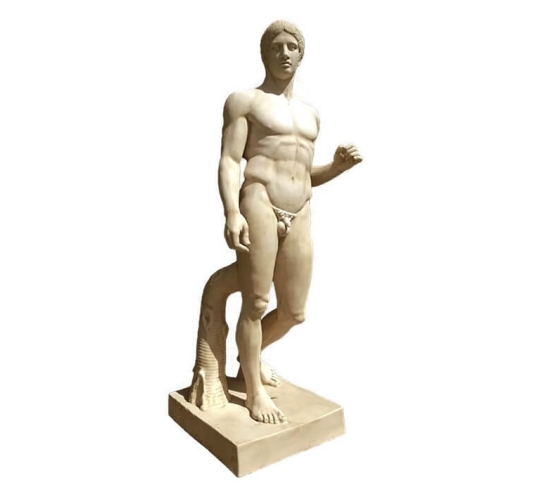- New
Doryphoros - life-size statue - the spear-bearer
This reproduction is only available for rental.
For statues available for rental, we invite you to contact us in advance by email or via our contact form so that we can study your project in detail.
Our rental quotations are based on periods of 3, 7 or 14 days. For different periods, we can provide you with a quotation adapted to your project.
Whatever your rental project, our workshop will send you a free and personalised quotation. This quotation is required because shipping costs differ not only from one statue to another, but also from one carrier to another.
No payment will be accepted before the quotation has been validated.
Dimensions
Height: 170 cm.
Material: polyester resin.
In stock
For more information, please contact us:
Contact form :
Email :
The original Doryphoros of Polyclete is a 78,74 " high statue made of marble. It depicts a naked young man, who originally held a spear in his left hand, hence his name Doryphoros, which in Greek means "spearheader".
It is believed to date from 440 BC. The young man was once recognized as Achilles because of his perfect proportions, so much so that he even served as a role model. In antiquity, it was called Kanon.
This work presents several emblematic features of Greek classical sculpture creations. Polyclete was able to restore a posture that later became very popular: the contrapposto. This model consists of representing a man in which only one of the two legs carries body weight, while the other at rest is slightly bent and carried backwards.
This sculpture found in Pompei in the Samnite Palace was part of a decoration made during the time of Augustus. It was certainly placed there to serve as a model for the young Roman aristocrats, as an image of physical perfection to which intellectual perfection must correspond, according to the Greek tradition of Kalos Kagathos, καλὸς κἀγαθός ("the handsome and good man").
This masterpiece has been an incomparable success, from the time of Polyclete to the present day. It symbolizes the perfect man, the physical ideal in its plastic representation and refers us to the greatest heroes of mythology, including Achilles.
Polyclete and his vision of art
Polyclete is a 5th century Greek sculptor, originally from Sicyone, but who lived mainly in Argos.
He inherited all the traditions of the Argian school, and was one of the greatest artists of his time.
He is best known for carving the famous Doryphoros. Polyclete was only a sculptor, but he took his place at the forefront of his art, next to his illustrious contemporaries, Phidias and Myron.
Above all, he was admired for his perfect technique and sense of proportion. He had many students: Antiphanes, Asopodoros of Argos, Athenodorosof Clitor, Canachos the young, Dinon, Aristide, Dameas de Clitor, Périclytos. Moreover, all the Argian sculptors of the 4th century were influenced by it, particularly those whose works were found in Olympia, Delphi and the Heraion of Argos.
For a Greek artist of Pericles' time, the human figure was only an image, a reproduction, but this mirror had to reflect a real man who had lived. It was necessary to take into account the movement, the way it was perceived, including if necessary by correcting the spectator's impression by "eurythmic" adjustments.
The Greek theory of proportions has been implemented and developed to meet these criteria, in contrast to the Egyptian criteria. Some proportions were considered ideal, but the artist had the right, if he so wished, to introduce subjective variations or to render anatomical variations or shortcuts.
According to Polyclete's successors, the torso and legs must be the same height, the pelvis and thighs two-thirds and the head one-third. The Doryphoros is a very good example of all these theories.



